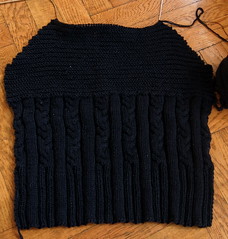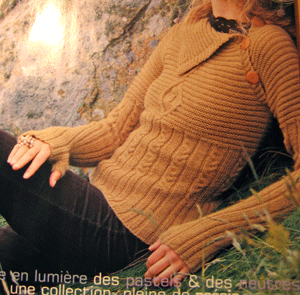Progress Shot + More on Raglan and Bind Off
First progress shot:

So I started on the raglan line and am now having doubts about the translation. At this point it's nothing specific, just, you know, the general feeling that I'm doing something wrong. Does anyone else have any thoughts on the translation?
Okay, here's where we left off.
On both sides...
1) *4 rows up, bind off 1 stitch, two rows up bind off 1 stitch, and another two rows up bind off 1 stitch.* Repeat these rows (* to *) 5 times. (I think this has to mean 5 repeats total, not 1 + 5 repeats, because of the way the numbers work out later, see below)
Is that correct?
Anyway, here's a stab at the next bit:
Meanwhile, at ...
1) 29 cm (92 rows) 2) 30 cm (96 rows) 3) 31 cm (100 rows) 4) 32 cm (102 rows) 5) 33 cm (106 rows) of godron stitch, form the neckline by binding off the 1)2)3) 12 4)5) 14 center stitches. Then continue one side at a time, binding off the side of the neckline 4 stitches every other row 2 times.
The math seems to confirm this as right, at least for the smallest size (someone please check this!)
76 (starting # after initial bind-off of 3 on each side)
-30 (bound off during 8-row repeats, assuming 5 repeats)
-18 (bound off during every-other-row repeats)
-12 (center neckline bind off)
- 8 (right side neckline bind off)
- 8 (left side neckline bind off)
----
0 stitches remain
Given the fact that there's some overlap between the neckline and raglan decreases, how many stitches should be the needles when you get to the neckline decreases? I am probably almost there, but think I might have left out or included a few raglan bind-offs. I'd rather make up for it before getting to the neckline, so it would be nice to know how many I'm supposed to have when I get there.
In the search for the definition of "encolure," I found this knitting term translation page, which is more comprehensive than the other one.




